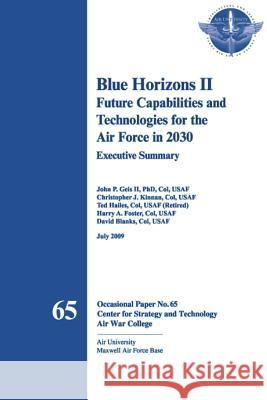Blue Horizons II - Future Capabilities and Technologies for the Air Force in 2030 » książka
Blue Horizons II - Future Capabilities and Technologies for the Air Force in 2030
ISBN-13: 9781478350705 / Angielski / Miękka / 2012 / 60 str.
In 1996 the Air Force initiated a major study effort under the direction of Gen Ronald R. Fogleman, the Air Force chief of staff. That study, Air Force 2025, looked 30 years into the future and made enormous contributions toward directing Air Force research and procurement. In 2007 Gen T. Michael Mosley, Air Force chief of staff, directed a continuous series of future thinking and study efforts be undertaken, using Air University (AU) as the "Air Force's think tank." This study, Blue Horizons, was commissioned by the United States Air Force (USAF) chief of staff to provide "a new look at the future." Specifically, the chief of staff asked the research team to provide "a common understanding of future strategic and technological trends for Air Force leaders to make better decisions." The chief also sought to "confirm AU as the Air Force's] in-house think tank" and to improve the relevance of Air Force education to the decision- making processes in Washington.1 The best and brightest officers from the Air Force and the sister services participated during their one-year AU courses of instruction, building four alternate scenarios to act as a foil to evaluate future systems and technologies, to determine the optimum path forward for Air Force investment. These senior officers each spent a year researching and traveling to their respective regions of concern. In the end, the team built four scenarios based on challenges found in the National Security Strategy. These scenarios include a resurgent Russia, a peer China, a jihadist insurgency in the Middle East, and a failed-state scenario in West Africa. The authors then evaluated 58 potential future systems or concepts and 172 key enabling technologies to determine what capabilities the Air Force would need to maintain superiority in air, space, and cyberspace to the year 2030. Occasional Paper No. 65, Center for Strategy and Technology, Air University Press.
Zawartość książki może nie spełniać oczekiwań – reklamacje nie obejmują treści, która mogła nie być redakcyjnie ani merytorycznie opracowana.











